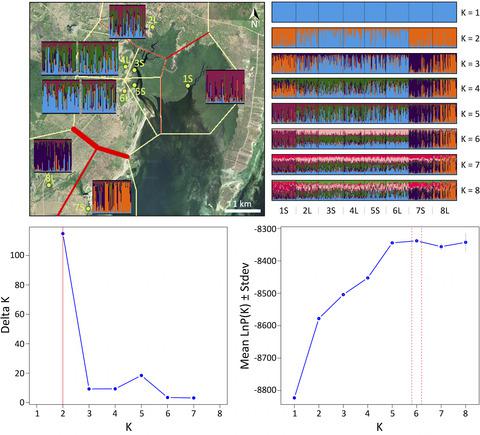当前位置:
X-MOL 学术
›
Ecol. Evol.
›
论文详情
Our official English website, www.x-mol.net, welcomes your feedback! (Note: you will need to create a separate account there.)
Channel network structure determines genetic connectivity of landward–seaward Avicennia marina populations in a tropical bay
Ecology and Evolution ( IF 2.6 ) Pub Date : 2020-10-16 , DOI: 10.1002/ece3.6829 Ludwig Triest 1 , Tom Van der Stocken 1 , Abbie Allela Akinyi 1 , Tim Sierens 1 , James Kairo 2 , Nico Koedam 1
Ecology and Evolution ( IF 2.6 ) Pub Date : 2020-10-16 , DOI: 10.1002/ece3.6829 Ludwig Triest 1 , Tom Van der Stocken 1 , Abbie Allela Akinyi 1 , Tim Sierens 1 , James Kairo 2 , Nico Koedam 1
Affiliation

|
Mangrove ecosystems along the East African coast are often characterized by a disjunct zonation pattern of seaward and landward Avicennia marina trees. This disjunct zonation may be maintained through different positions in the tidal frame, yielding different dispersal settings. The spatial configuration of the landscape and coastal processes such as tides and waves is expected to largely influence the extent of propagule transport and subsequent regeneration. We hypothesized that landward sites would keep a stronger genetic structure over short distances in comparison with enhanced gene flow among regularly flooded seaward fringes. We tested this hypothesis from densely vegetated A. marina transects of a well‐documented mangrove system (Gazi Bay, Kenya) and estimated local gene flow and kinship‐based fine‐scale genetic structure. Ten polymorphic microsatellite markers in 457 A. marina trees revealed no overall significant difference in levels of allele or gene diversities between sites that differ in hydrological proximity. Genetic structure and connectivity of A. marina populations however indicated an overall effect of geographic distance and revealed a pronounced distinction between channels and topographic setting. Migration models allowed to infer gene flow directionality among channels, and indicated a bidirectional steppingstone between seaward and nearest located landward stands. Admixed gene pools without any fine‐scale structure were found within the wider and more exposed Kidogoweni channel, suggesting open systems. Elevated kinship values and structure over 5 to 20 m distance were only detected in two distant landward and seaward transects near the mouth of the Mkurumuji River, indicating local retention and establishment. Overall, our findings show that patterns of A. marina connectivity are explained by hydrological proximity, channel network structure, and hydrokinetic energy, rather than just their positioning as disjunct landward or seaward zones.
中文翻译:

通道网络结构决定了热带海湾内陆向海的Avicennia滨海种群的遗传连通性
东非沿岸的红树林生态系统通常以海洋和陆地Avicennia滨海树的分离分区模式为特征。可以通过潮汐框架中的不同位置来维持此分离分区,从而产生不同的分散设置。预计景观和沿海过程(如潮汐和海浪)的空间配置将在很大程度上影响繁殖体运输和后续更新的程度。我们假设,与定期淹没的沿海带中增强的基因流相比,登陆点在短距离内将保持更强的遗传结构。我们从茂密的A. marina码头验证了这一假设一个有据可查的红树林系统的横断面(肯尼亚加兹湾),并估计了当地的基因流和基于亲缘关系的精细遗传结构。457 A.滨海树中的十个多态微卫星标记显示,在水文邻近性不同的位点之间,等位基因或基因多样性水平没有总体上的显着差异。滨海曲霉的遗传结构和连通性然而,人口显示了地理距离的整体影响,并揭示了渠道与地形环境之间的明显区别。迁移模型可以推断通道之间的基因流方向性,并指出了海向和最近的陆向林分之间的双向踏脚石。在更宽,暴露程度更高的Kigowoweni通道中发现了没有任何精细结构的混合基因库,表明是开放系统。仅在Mkurumuji河口附近的两个遥远的陆上和海面样貌中检测到亲缘关系值和结构在5至20 m的范围内升高,表明存在局部保留和建立。总体而言,我们的发现表明,滨海假单胞菌的模式 连通性是通过水文邻近性,河道网络结构和水动力来解释的,而不仅仅是将它们定位为分离的陆上或海上区域。
更新日期:2020-11-13
中文翻译:

通道网络结构决定了热带海湾内陆向海的Avicennia滨海种群的遗传连通性
东非沿岸的红树林生态系统通常以海洋和陆地Avicennia滨海树的分离分区模式为特征。可以通过潮汐框架中的不同位置来维持此分离分区,从而产生不同的分散设置。预计景观和沿海过程(如潮汐和海浪)的空间配置将在很大程度上影响繁殖体运输和后续更新的程度。我们假设,与定期淹没的沿海带中增强的基因流相比,登陆点在短距离内将保持更强的遗传结构。我们从茂密的A. marina码头验证了这一假设一个有据可查的红树林系统的横断面(肯尼亚加兹湾),并估计了当地的基因流和基于亲缘关系的精细遗传结构。457 A.滨海树中的十个多态微卫星标记显示,在水文邻近性不同的位点之间,等位基因或基因多样性水平没有总体上的显着差异。滨海曲霉的遗传结构和连通性然而,人口显示了地理距离的整体影响,并揭示了渠道与地形环境之间的明显区别。迁移模型可以推断通道之间的基因流方向性,并指出了海向和最近的陆向林分之间的双向踏脚石。在更宽,暴露程度更高的Kigowoweni通道中发现了没有任何精细结构的混合基因库,表明是开放系统。仅在Mkurumuji河口附近的两个遥远的陆上和海面样貌中检测到亲缘关系值和结构在5至20 m的范围内升高,表明存在局部保留和建立。总体而言,我们的发现表明,滨海假单胞菌的模式 连通性是通过水文邻近性,河道网络结构和水动力来解释的,而不仅仅是将它们定位为分离的陆上或海上区域。


























 京公网安备 11010802027423号
京公网安备 11010802027423号